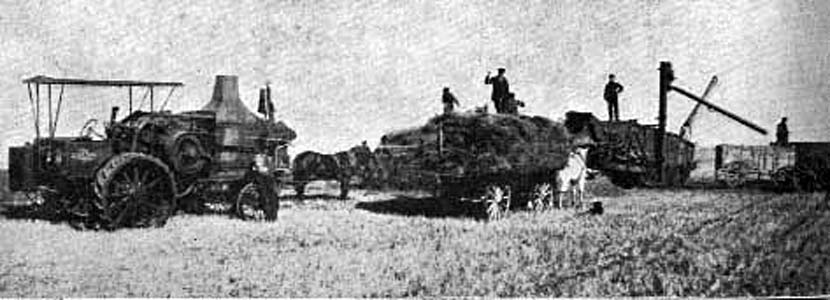Search | Image Archive | Reference | Communities | POV | Lesson Plans | Credits
 The most important piece of equipment in a threshing operation was the thresher, or separator, itself. The job of the separator was to separate the head from the straw, and then further to separate the kernel from the rest of the head.
The most important piece of equipment in a threshing operation was the thresher, or separator, itself. The job of the separator was to separate the head from the straw, and then further to separate the kernel from the rest of the head.
Separators were generally not equipped with their own power and were usually driven by means of a wide rubber belt. Originally, these belts were driven by a treadmill walked by horses or oxen. By the 1890s, most threshing machines were driven by a steam engine, and by 1915, lighter and easier to maintain gasoline tractors were beginning to appear on the prairies.
The typical separator had three stages. The first was the feeder. This was an adjustable hopper which controlled the passage of grain and straw into the machine and prevented overloading. The second stage was the separator itself. Within the separator, the grain was passed through a slot between a toothed cylinder which rotated at high speed and a grooved plate. The cylinder beat the grain into the plate, knocking the kernel from the head, but not crushing it.
The grain was then raked off the grooved plate and onto the straw rack, a coarse grille which removed much of the straw from the grain. The grain and chaff small enough to pass through the straw rack fell upon the shoe, a series of progressively smaller sieves which separated most of the remaining straw and chaff from the grain.
The third and last stage in the threshing machine was the stacker. Grain passing through the lowest sieve in the foot passed in front of a concentrated stream of air emitted from the blower. Heavy grains were unaffected by the the blower and fell down into a hopper where they were drawn off into bags, but any remaining light particles of straw and chaff which had worked their way through the sieves were blown off.
While many improvements were made to the tractors that drove the threshing machine, the separator itself remained largely unchanged until the appearance of the combination harvester (combine) in the late 1920s, which could both cut and thresh at the same time. The combine did not, however, make the portable threshing mill obsolete and many remained in use through the 1940s.
Page revised: 29 August 2009